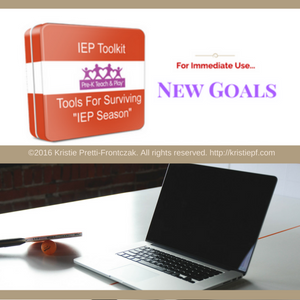 How do you ensure IEP goals and objectives, particularly for preschoolers, are not only legally defensible, but meaningful to children and their families?
How do you ensure IEP goals and objectives, particularly for preschoolers, are not only legally defensible, but meaningful to children and their families?
It seems like a lifetime ago, when at the University of Oregon, I asked a fellow doctoral student, “How do you know what criteria to write on a child’s IEP goal?” I was desperate to learn the secret to picking 4/5 vs. 2/3…
Know what my fellow doctoral student said?
“You just mix it up!”
Since that day, my quest for the secret to writing GOOD IEP goals has continued. I’ve read just about everything on the topic, conducted research studies, attended trainings, and still…I struggle.
I struggle with the paradox of measurable and meaningful goals.
As we all know, the more measurable the goal, the less we care about it. And the more we care about it, the harder it is to measure. A classic example is the goal that states a child will cross the street with 80% accuracy!
Crazy right?
Finding the balance between measurability and what matters is even harder when we are working with preschool age children, aiming to abide by K-12 preferences for how IEPs are written and measured…oh and then toss into the mix that the child has a diagnosis of ASD.
Hence, my constant search for tips, tools, and techniques!
All this searching has lead me to three things that will help make any IEP goal “better.”
First, know what it is you want. What is the team wanting to see a child know or do?
Here are a few ways to check to make sure you have a clearly identified “what”:
- Write the “what” in observable terms so team members can see/hear the “what”
- Ensure the “what” is culturally and individually appropriate and is in the sweet “ZPD”
- Be clear what the “what” is NOT (see example below)
Sample Goal Statement: During child led activities, when a familiar adult builds upon what the child said/did with or without the involvement of objects, the child will take any action (e.g., imitate adults verbalization/action, make a new motor verbalization/action) that serves to continue a back-and-forth exchange with the adult.
This sample is not about compliance…This sample is not about predetermined child response…This sample is not about single exchange, rather, the ideal would be to aim for three or more exchanges.
See how knowing “what” it isn’t…helps know “what” it is?
Second, have you written your “what” in a way that it can be measured? Now don’t skip this step thinking that because you’ve added a %, the statement is measurable…and remember, now that it is measurable, you may have lost some of what matters.
Here are a few ways to check to make sure your “what” is measurable:
- Ensure expectations for the child’s performance are clear. In other words, make sure team members know if the child should do something more frequently, vs. more quickly, vs. with more accuracy, etc.
- Identify how many opportunities might occur throughout daily activities for the child to receive a complete learning trial related to the “what”
- Develop a clear way to know how the child is responding to instructional efforts and when efforts should be modified
Third, check back to make sure the “what” matters.
Here are a few ways to check to make sure your “what” matters:
- The “what” increases a child’s access, participation, and progress in appropriate daily activities (aka the child needs the “what” most of the time or in many situations)
- The “what” stems from a need that is because the child has an identified disability or delay
- The “what” require specially designed instruction
That’s it…just three tips, from me to you…to ensure IEP goals that matter!
P.S. For training on writing legally defensible and meaningful IEP goals, contact me today!
P.P.S. If you are looking for more tips, check out my free Pre-K Teach & Play IEP Toolkit.